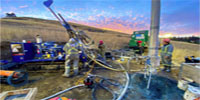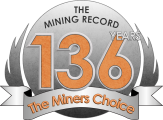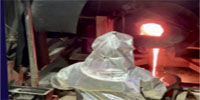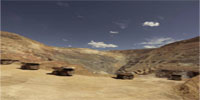
New Porphyry Copper/Skarn Target Strengthened With Gold Grades And New Silver Zone
TORONTO – Hercules Silver Corp. reported on new gold geochemical results from mineralized skarns and breccias at the Metheny, Big Cut and Lightning Breccia Zones on the Hercules Property located in western Idaho. The company previously reported 4-acid assay results for silver, lead, zinc and copper from over 800 rock chip samples within soil anomalies across the Property. A 4-acid digest provides superior analytical results versus a typical aqua regia digest, due to the complete digestion of the sample, however gold values are not reported. The Company subsequently fire assayed select rock samples within the porphyry copper target area, which revealed the presence of gold in bedrock. The gold is associated with mineralized skarns as well as a breccia pipe, both of which are interpreted to be the near-surface expression of a buried porphyry copper target.
Surface data suggests that the source intrusion responsible for the copper-gold mineralization at surface lies deeper in the system. The geology at surface is typical of the upper levels of a porphyry copper deposit, including phyllic and argillic alteration associated with the copper-gold anomaly, and widespread propylitic alteration outboard of that to the east. This is classic zonation around and above a porphyry copper system, where the higher-grade potassic alteration occurs at depth, below the phyllic and argillic cap.
In the CRD deposit model, the silver-lead-zinc grades increase towards the edge of the porphyry copper intrusion. As a result, the Company may expect to find higher silver-lead-zinc grades at depth, as the rhyolite approaches the buried porphyry copper intrusion (also inferred to lie at depth). This is supported by the presence of a large IP chargeability anomaly at depth in the rhyolite, for additional information. Chargeability is a geophysical technique aimed at measuring the concentration of sulfide mineralization in the ground. The higher chargeability values at depth within the rhyolite suggests an increase in sulfide concentration, which in turn lends itself to potentially increased grades at depth.
Two high-grade copper-silver targets, the Big Cut and Metheny Zones, occur within the Triassic Seven Devils Group on the east side of the Property. Both targets demonstrate skarn-style mineralization which occurs where limestone comes in contact with, or lies within close proximity to, a nearby porphyry intrusion. The Big Cut Zone is classified as a garnet-epidote skarn, whereas the Metheny is a specularite (iron) skarn. The differing alteration is likely a function of zonation around a potential porphyry intrusion or multiple intrusive centers at depth..






